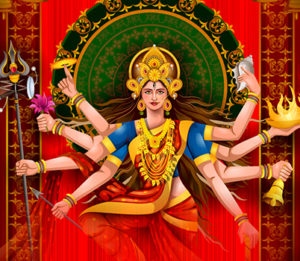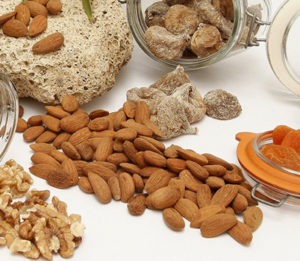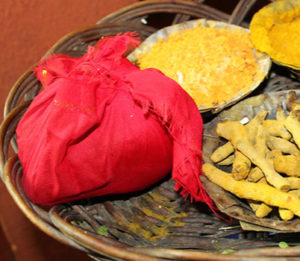Navratri is the time of the Goddess. Nine nights of honouring the Devi who took many forms to vanquish evil and bring relief to her children. The cult of the Mother Goddess has existed in India since ancient times. This form of worship is based on the feminine principle or Shakti, without which there would be no life. But this energy is both creative and destructive. It is both nurturing and fierce. Her blessings can fill your life with abundance and joy, but her wrath can make even demons quake with fear. Even the gods failed to destroy Mahishasura. It was Goddess Durga who killed him after a terrible battle that lasted 9 days and 9 nights – the event that we celebrate as Navaratri.
The meaning of Navratri is ‘nine nights’. During these 9 days and nights, Hindus in India worship 9 forms of the Devi or Mother Goddess. There are 4 major Navratris in a year, but only two are celebrated. ‘Chaitra Navaratri‘ celebration is the first and it happens during the summer (March-April), while ‘Sharad Navaratri’ is the second which happens during winter (Oct-Nov). The other two Navratris are called Gupt Navratri. ‘Gupt’ means “secret”. Now, people observe Vrat (fast), and perform Poojas and sadhana during this period too. Gupt Navratri was not very popular earlier, but things are changing now.
Many people observe Vrat during Navratri. They do so in order to become more spiritual and to invoke the Goddess’ energy or to purify their minds and bodies.
Navratri fasting involves some rules which need to be strictly followed.
Food items you can eat during Navratri Vrat
- Singhade ka Atta, Kuttu ka Atta, Rajgira, Sama ka Atta, Sama ke chawal, Sabudana, Phool makhana
- All kinds of nuts and seeds
- Rock salt, black pepper, cardamom, cumin powder can be used for cooking
- Green chilies, ginger root, coriander leaves, and lemon juice as seasoning
- All seasonal fruits
- Raw sugar, honey, jaggery, regular sugar
Things to be avoided
- Non veg food
- Cereals and pulses
- Packaged food items
- Garlic, onion, table salt
- Alcohol
- Candy, cold drinks, chocolate
- Packaged chips, biscuits
Pooja Vidhi for Navratri
This year, Navratri festival begins on October 17. Shailaputri (one of the nine forms of the goddess) pooja is performed on this day. The festival ends on October 26 with Durga Visarjan (immersion of the idol) and Vijaya Dasami celebrations.
Shardiya Navrtri Ghatasthapana — which marks the beginning of the festivities — will be on October 17. Ghatasthapana is a very important ritual and it marks the beginning of the festival. As it is done to invoke the Goddess, it should be done at the right time, and the scriptural rules and guidelines need to be followed.
Sandhi Pooja is also important during Navratri. It is performed when Ashtami Tithi ends and Navami Tithi starts. The belief is that Devi Chamunda appeared at this time to slay the demons, Chanda and Munda. The Pooja lasts around 48 minutes.
The nine forms of Durga are worshipped on the nine nights of Navaratri. The festival begins with Shailaputri Pooja. This is followed by Poojas for Brahmacharini, Chandraghanta, Kushmanda, Skandamata, Katyayani, Kalaratri, Mahagauri and Siddhidatri. Each goddess is an avatar of Durga, but possess unique powers and personalities.
Pooja Vidhi
For the ghatasthapana (invocation of the goddess with the installation of the sacred kalash or Pooja pot) the items needed are
- A wide and open clay pot
- Clean soil
- Barley seeds
- Ganga jal or sacred water for the kalash
- 5 betel nuts, a 5 rupee coin
- Five Ashoka or mango tree leaves
- Rice, coconut, red cloth, flowers, and garland.
The most auspicious time for the ghatasthapana is the first one-third of the day when Pratipada still prevails. If this is not possible, ghatasthapana can be performed during Abhijit Muhurta. It is better to avoid Chithra Nakshatra and Vaidhriti Yoga during the ritual, though they are not prohibited. The most important thing is to perform the ghatasthapana before Hindu midday.
Procedure for Ghatasthapana
Spread the red cloth on a clean area, where the Pooja is to be performed. Place Goddess Durga’s picture on it. Spread red soil on the cloth and sprinkle some water on it. Sow some barley seeds in the soil, and keep an earthen pot in the middle. Pour some ganga jal in the pot and drop some roli (kumkum), the betel nuts, and the 5 rupee coin into it. Place some mango leaves on the mouth of the kalash, and keep a lid on the pot. Put some rice on the lid and keep a coconut covered in red cloth on the lid.
Daily Pooja Procedure
Light the lamp and some incense sticks. Offer flowers to the Goddess and decorate the idol using chandan (sandalwood paste), vermilion, and turmeric paste. Every day, when performing the Pooja, sprinkle some water on the seeds. Offer the special dishes you prepared as Prasad. The Prasad or bhog should not be tasted before the Pooja ends. Perform arati to Durga and distribute the Prasad to family and friends. This Pooja should be done for 9 days.
8th Day Pooja
Perform the Pooja as usual. Invite nine small girls to your home. They are regarded as the nine forms of the Goddess. Give them a special meal and some small gifts.
Visarjan on the 10th Day
Visarjan ritual is done on the 10th day. This is the ritual of giving a send off to the Goddess after the 9 day Poojas. After the Pooja is over, sprinkle the water in the kalash in all rooms of the house. Feed birds with the rice that was kept on the kalash lid. On the last day of Navaratri, the sprouted barley seeds must be immersed in a water body like a river or pond. If there is no water body nearby, place the seeds under a tree in your garden or a pipal tree in a temple.
The festival is celebrated in different ways in different parts of India. In West Bengal, the celebrations begin on the sixth day, and they are part of the Durga Pooja festival. In Karnataka, the ninth day of Navratri is celebrated as Ayudha Pooja.
« Try a Gratitude Experiment Powerful Ways to Celebrate Navaratri While in Lockdown or Self-Isolating »




